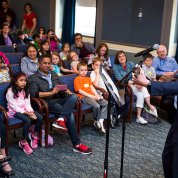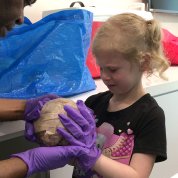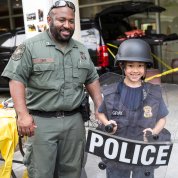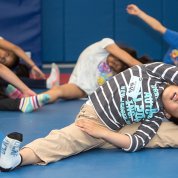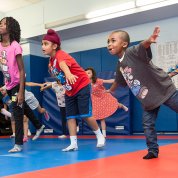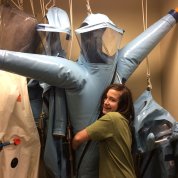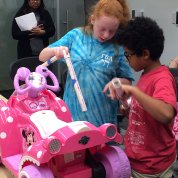Kids Enjoy Learning at TYCTWD/Earth Day
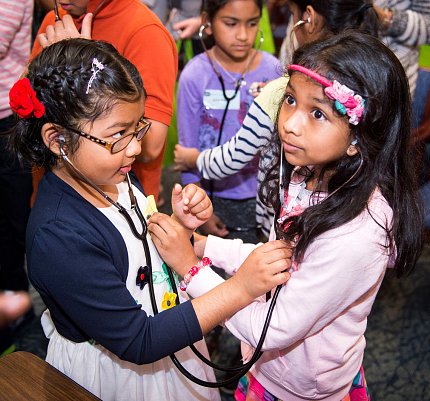
Photo: Lisa Helfert
NIH was teeming with kids on Apr. 27. They skipped across campus, hand in hand with parents and guardians, brimming with enthusiasm and curiosity. It was another successful Take Your Child to Work Day/Earth Day that enlightened bright, young minds about the many wonders of health and science.
Dozens of fun, educational activities both on and off campus kept the budding scientists engaged. Through arts and crafts, games, simulations and hands-on experiments, kids learned about anatomy, genetics, disease and the environment.
Little apprentices could be seen decked out in scrubs heading to the Clinical Center’s operating room to learn about robotic surgery. Others took a Fantastic Voyage, peering into petri dishes, vials and microscopes to learn about phlebotomy and microbiology. In the CC’s rehabilitation clinic, physical therapist Melissa Waite led balance and coordination exercises.
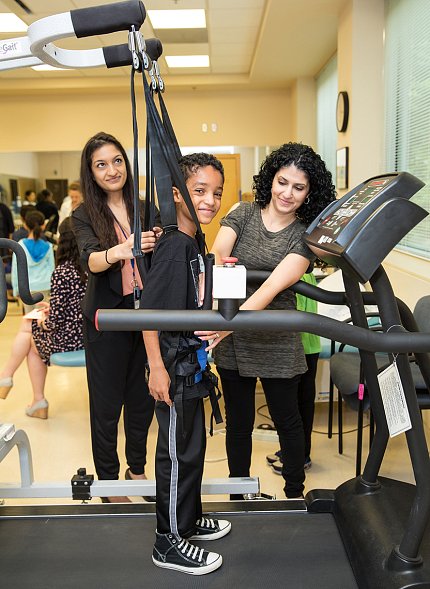
Photo: Chia-Chi Charlie Chang
Diane Aker, a nurse in the CC’s bone marrow transplant unit, took her two daughters, Catherine, 10, and Mary, 12, to work that day. Mary said their favorite activity was touring the CC’s special clinical studies unit and seeing the protective gear staff wear while tending to highly infectious patients.
NIH’ers from just about every IC hosted creative activities throughout the day; even postdocs got involved. Hundreds of kids came by 7 tables of activities run by postdoctoral fellows along the CC’s 7th floor breezeway. These included information about DNA, the senses, bacteria, viruses and microbes. The fellows were as excited as the kids. “The fellows got a lot of teaching and mentoring experience, interacting with the kids,” said Erika Barr of the Office of Intramural Training and Education.
At one station, kids built a mouse chromosome to determine its color. Using beads that represented genes, they learned about dominant and recessive genes.
“I told the kids it’s like making a cupcake of your favorite flavor,” said Lymarie Maldonado-Baez, an NINDS postdoc. “The steps of the recipe are the same, but the ingredients are different.”
OD featured several new events including “Hacked,” which showed children what bad guys see when they compromise your computer. Another new activity was “Outrageous Ozobots,” in which children learned how to code their own mini robot. Youngsters also learned how white blood cells, or police of the body, fight robbers of their health and separated dyes from candy in a “Candy Chromatography” activity. More than 375 children participated in the various OD activities.
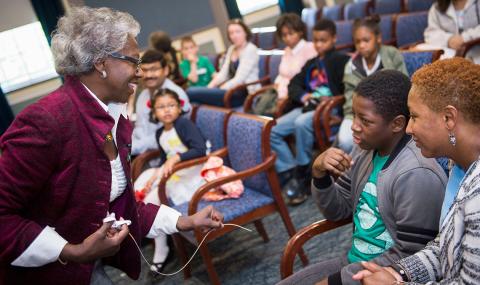
Photo: Lisa Helfert
Over in the Eye Clinic on the 10th floor, Dr. Rachel Bishop, chief of NEI’s consult services section, talked with a group of kids before they divided into smaller sections to tour the optical diagnostic and treatment labs. When she asked how we can protect our eyes from chemicals, machinery and sports injury, one kid exclaimed, “Dodge it?” to laughter. Others more seriously suggested goggles and helmets.
“You’ve been given this incredible body to keep healthy throughout your life,” Bishop said, “and your first job is to take care of yourself in every way you can.” They discussed how simple steps such as washing hands, eating right (including vitamin A and lutein, which promote healthy eyes), wearing sunglasses and sunscreen, exercising and getting enough sleep are important for eye and overall health.
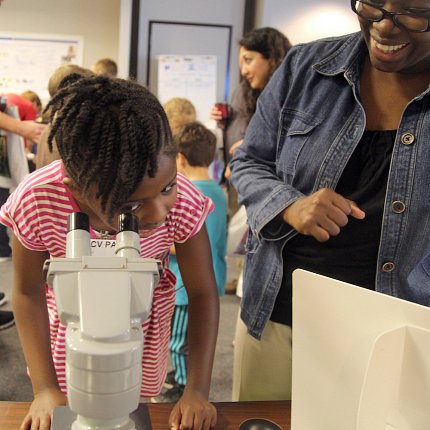
Photo: Meredith Daly
In the diagnostics lab, NEI technician Dessie Koutsandreas let kids try out different gadgets and tests for eyesight, color, glare and depth perception. The Office of Disease Prevention’s Deborah Langer proudly watched her son Brent, age 9, try some of the tests. She wanted him to attend this session, she said, because his grandpa was an ophthalmologist and she wants Brent to learn about the profession.
“I like these types of small events where the kids can do lots of hands-on experiments,” Langer said. “There is just so long that kids this age can stay focused on one activity.”
The day also featured larger, open activities where anyone could drop by without reserving a spot. On the Bldg. 31 patio, the NIH Police welcomed kids who petted Copper, a K-9 unit dog, tried on safety gear and ran through agility tests similar to the fitness tests NIH officers must pass before being hired.
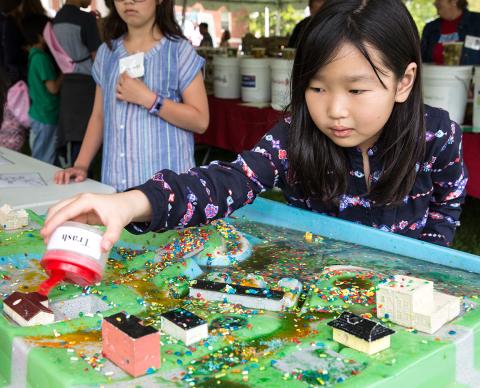
Photo: Chia-Chi Charlie Chang
On the Natcher and Bldg. 1 lawns, hundreds of kids and their parents stopped by Earth Day exhibits to learn about environmental threats such as pollution and climate change and ways each of us, big and small, can help protect the Earth by recycling, composting and conserving energy and water.
It was a gorgeous day, perfect for celebrating Earth and its resources. Some kids took a guided stroll to the NIH stream to learn about plants and wildlife. Outside Bldg. 1, youngsters visited an Audubon Society exhibit where they could pet a 30-year-old Russian tortoise, who kept his head poked out of his shell, seemingly unafraid of the small hands reaching for him. Other kids fearlessly held earthworms while learning about making compost.
Back inside, in the Bldg. 31 basement, kids got a hands-on lesson in CPR from Juliann Egebrecht, director and coordinator of NIH’s Basic Life Support Training. Down the hall, in the gym’s group exercise room, parents watched through the window as their kids balanced and stretched in PiYo (pilates-yoga) and beat drumsticks.
By late afternoon, many of the youngsters were still bouncing around while their parents looked proud but exhausted. There’s a good chance adults and kids alike slept well that night.

